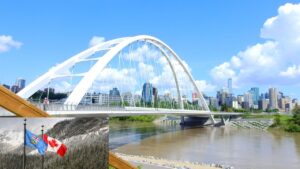
Explore the easiest provinces to get permanent residence in Canada. You may be wondering which provinces offer the easiest pathways to achieve this goal. Certain provinces have specific programs that make the process even smoother.
While many provincial nominee programs demand ties to the province, other programs only consider applicants who can fill demographic or labor needs.
Which provinces make it easier for applicants without Canadian ties to obtain PR?
1. Saskatchewan

The first province most likely to nominate you for immigration is Saskatchewan. Saskatchewan is known for having one of the most straightforward immigration processes in Canada. The province offers a variety of immigration programs, including the Saskatchewan Immigrant Nominee Program, which allows individuals with the required skills and experience to apply for permanent residence.
Saskatchewan’s International Skilled Worker PNP and Occupations In-Demand are intended to draw in candidates who have experience in the in-demand occupations in the province. These international skilled worker streams use an Expression of Interest (EOI) system to select applicants.
In contrast to other Canadian provinces where only points for blood relatives are given, this province gives candidates who have family or a cousin living in Saskatchewan an additional CRS score.
Saskatchewan also has a strong economy and a low cost of living, making it an attractive option for individuals looking to settle in Canada.
2. Alberta

Alberta is Located in western Canada, and it is one of the three beautiful Prairie Provinces.
Alberta boasts a strong economy driven by the oil and gas industry, making it a sought-after destination for skilled workers. The Alberta Immigrant Nominee Program (AINP) provides various pathways to permanent residence, including streams for skilled workers, international graduates, and entrepreneurs.
one major benefit of Alberta’s immigration program is that the province invites candidates having CRS scores as low as 300. This happens throughout the year, meaning more candidates in the pool could receive notices of interest from Alberta. However, having a CRA score of 300 does not guarantee an invitation from Alberta.
Alberta will issue 9,750 nomination certificates this year, split between Express Entry and non-Express Entry pathways. This number will increase to more than 10,000 nomination allocations per year in 2024 and 2025.
The province also offers a lower cost of living than other major cities in Canada, making it an attractive choice for those looking for affordable housing options.
3. Ontario

With its vibrant cities, robust economy, and numerous job opportunities, Ontario is a popular destination for immigrants. The province operates the Ontario Immigrant Nominee Program, which allows skilled workers, international students, and entrepreneurs to apply for permanent residence through specific streams tailored to their qualifications and experience. In addition, Ontario’s capital city, Toronto, offers a culturally rich and diverse community, making it an attractive choice for newcomers.
Over 20% of Canada’s population is in Ontario. because of this, the province has a large quota for nominating immigrants through PNP streams.
Ontario holds frequent draws because of its high immigration quotas, making it one of the simpler provinces to obtain residency in. The only downside is that most draws require applicants to have CRS scores of 400 points or higher, which is unattainable for most express-entry applicants.
Under the Ontario Immigrant Nominee Program’s Human Capital Priorities stream, 1,696 invitations for permanent residency were issued on the 26 of September. If you are an applicant outside of Canada, Ontario might be a great option.
Also Read: How to find farm jobs in Canada
4. Nova Scotia

Nova Scotia is a beautiful Atlantic province surrounded by more than 3,800 coastal islands. It’s Canada’s second-smallest province. It is famous for its rolling green hills and towering sea cliffs on its beautiful beaches.
The Nova Scotia Immigration Program (NSNP) is a provincial immigration program that allows skilled workers and their families to immigrate to Nova Scotia, Canada. The program is designed to attract individuals who have the skills and experience required by the province’s labor market and who are interested in living and working in Nova Scotia
Candidates are selected directly from the express entry pool. it is considered one of the easiest provincial nominee programs for foreign applicants because the province invites candidates without a connection to the province. Potential nominees must have a valid Express Entry profile and express an interest in Nova Scotia. One drawback is that Nova Scotia does not publish its chosen occupation or target criteria in advance, so you can’t figure out how best to prepare.
Frequently Asked Questions
What is the Easiest Way to Get PR in Canada?
Here some are of the easiest ways to get permanent residence in Canada.
1. The Express Entry System
If you are a skilled worker and meet the necessary criteria, the Express Entry system might be the easiest way for you to obtain PR in Canada. This system is designed to efficiently manage and streamline applications for permanent residency. It uses a points-based system called the Comprehensive Ranking System (CRS) to assess and rank eligible candidates.
To increase your chances of obtaining PR through Express Entry, it is crucial to have a high CRS score. Your score is based on factors such as age, education, work experience, language proficiency, and adaptability. The higher your score, the better your chances of receiving an Invitation to Apply (ITA) for PR. Therefore, investing time and effort into improving your CRS score can significantly increase your chances of success.
3. Provincial Nominee Programs
Another popular and relatively easy way to obtain PR in Canada is through Provincial Nominee Programs (PNPs). Each province in Canada has its own PNP, which allows them to nominate candidates who meet their specific labor market needs.
PNPs often have lower eligibility requirements compared to federal programs, making them an attractive option for many applicants. They also provide opportunities for individuals with specific skills or work experience to settle in a particular province.
If you have a specific province in mind or possess qualifications that align with their needs, applying for a PNP could be a favorable option. However, it’s important to note that the eligibility criteria and application processes vary between provinces. Therefore, thorough research and understanding of the specific PNP requirements are essential.
3. Family Sponsorship
For individuals who have family members who are Canadian citizens or permanent residents, family sponsorship can be a straightforward route to PR. The Canadian government prioritizes family reunification and offers sponsorship programs for spouses, common-law partners, dependent children, parents, and grandparents.
To be eligible for family sponsorship, the sponsoring individual must meet certain eligibility criteria, such as financial stability and the ability to provide for the sponsored family member’s needs. The application process involves demonstrating a genuine relationship and fulfilling specific documentation requirements.
4. Study in Canada
Studying in Canada is not only a great way to gain quality education but also an opportunity to obtain PR. The Canadian government values international students and provides various pathways for them to become permanent residents.
Upon completing a qualified program of study at a designated learning institution in Canada, international graduates may be eligible to apply for a post-graduation work permit (PGWP). The PGWP allows graduates to gain valuable Canadian work experience, which can ultimately lead to PR through the skilled worker or Canadian Experience Class programs.
Moreover, studying in Canada can provide an advantage in the Express Entry system. Additional CRS points are awarded to international students who have completed their education in Canada, further enhancing their chances of receiving an ITA for PR.
When considering immigrating to Canada and obtaining permanent residence, it’s important to research and understand the opportunities available in each province. While the country offers a welcoming and diverse environment, certain provinces have specific programs and advantages that make the process easier. Whether you choose the bustling cities of Ontario and British Columbia, the economic opportunities of Alberta, or the quality of life in Saskatchewan, Canada has a province that can suit your needs and goals. Immigration is a life-changing decision, and by exploring these easiest provinces to get permanent residence, you’ll be one step closer to achieving your dream of calling Canada home.